Growing plants from seed is definitely the cheapest way to propagate plants for your garden, if you have the space to sow them and pot them on.
However if you are an urban-living gardener you might only have a window sill or balcony to grow your own herbs.
One of the things you can do is get a great double use out of your supermarket living herbs, by using some of them in cooking, and potting on the rest for later. You can even take cuttings from mint plants which will happily root and grow into new plants.
This pot was picked up in the bargain section of the supermarket, and cost 29p.
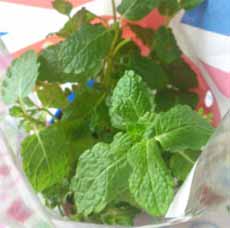
Mint plant
Why Supermarket Plants Fail
Overcrowding – The way that supermarkets make a good crop in a small container is to intensively plant the pot with more herb plants than the pot can sustain over a length of time. This is why the herbs you buy form the supermarket don’t live very long – unless you are lucky.
Intensive farming – Often the plants are produced quickly and hastily to make them cost effective for the grower and the supermarket. You will see from this picture that the 4 inch pot (10cm) has 3 mint plants stuffed into it. Each plant has been grown in a small ‘plug’ and three of these have been pushed into the compost, although you can in this case the plugs have not been firmly and fully inserted into the compost. This is another reason that supermarket herbs don’t thrive.
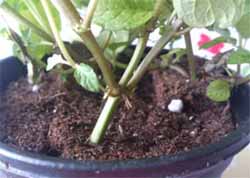
Overcrowded Herbs in a Pot
Wrong compost – Often supermarket plants are planted in soil or compost that is wrong for the plant. In the case of my mint this soil too moisture-retaining for it to be happy, and so this can lead to the leaves getting mould or black spot.
Neglect – staff in the supermarkets don’t have the time (or experience) to care for living plants, and so they need to be sold quickly so they find a loving home before they suffer from neglect.
How to Make Three Plants out of one
You can carefully separate out the three plants from the pot.
- Give the pot a good soak before you try to remove the plants. Place the mint pot in a container that is taller than the pot, fill it with water so the level is above the top of the pot and allow the plant to soak up the water for about 20 minutes.
- Drain off the excess water and allow the mint to drain for about 5 minutes
- Tip the pot out and carefully separate the roots from each of the 3 plants, try to cause as little damage as possible
- Re-pot each of the plants into 10cm/4 inch pots, using a mixture of potting compost and grit. Mint likes a free draining soil
- Trim the top growth (see below)
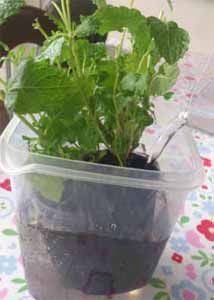
Herb Pot Well Watered
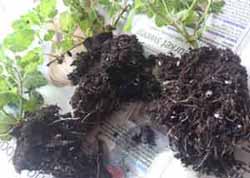
Carefully Separate Herb Plants at the Roots
When plants have suffered a bit of root damage they prefer their top growth to be trimmed too, so if you haven’t already used your mint tops in your cooking or Pimms then prune each plant by about a third of their length.
Water the plants again and find them a sheltered spot on the balcony or windowsill to recover from their ordeal.
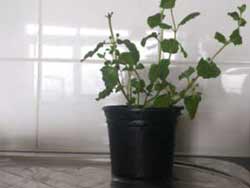
Newely Potted Herb Plant
The plants will soon start sprouting new growth, and when they are getting a bit big for their pots you can plant them in the garden if you have one. Alternatively you can invest in some attractive pots that will brighten up your balcony and will look great if you bring them inside.
If you have 3 plants on the go, you can have a rotating system where you have a usable bush on your kitchen windowsill, the recently pruned one and the regrowing one can live outside, until they are ready to swap back with the kitchen one.
If you use three different styles of pot you can keep changing your interior look too!
Even More Plants
You can also propagate mint and many other plants by rooting them in water before potting them on.
- Take a cutting, approximately 10 cm long (4 inches) using scissors or a sharp knife
- Remove all the lower leaves to prevent them rotting in the water
- Place the mint cuttings in a container of water. I like to use a glass or jam jar so I can see the root growth when it happens
- Place them out of direct sunshine and keep an eye on the water level
- Once the roots show you can pot the small plants into a mixture of compost and grit and place in a sheltered position to flourish and grow (as for the plants above)
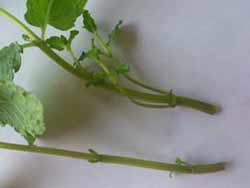
Mint Plant Cuttings
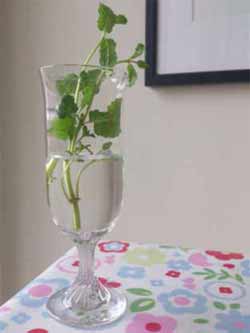
Mint Plant Ready to Pot

